
DIpil Das
Introduction
This report presents the results of Coresight Research’s latest weekly survey of US consumers on the coronavirus outbreak, undertaken on June 10. This report explores the trends we are seeing from week to week, following prior surveys on June 3, May 27, May 20, May 13, May 6, April 29, April 22, April 15, April 8, April 1, March 25 and March 17–18.Looking Beyond Lockdown
Consumers Selectively Resume Everyday Activities Lockdowns have eased or been lifted in most states, and retail stores have been gradually reopening since the beginning of May. In this context, we asked what consumers have done in the past two weeks and what they expect to do in the upcoming two weeks, providing them a choice of 16 options (as well as “none”). One-Third Have Bought Apparel Online in the Past Two Weeks Among the activities specifically related to spending, making an online purchase of apparel was the top option, with one-third of all respondents saying they have done so in the past two weeks. However, only 14.4% bought apparel in store—less than half the proportion that made purchases online. Online grocery shopping remains at elevated levels and was ranked the second spending-related activity, with a little less than one-third having done it. The top two options suggest that consumers still favored online activities over going outside in the past two weeks. Open-air shopping centers were preferred over enclosed shopping malls: Some 18.0% of respondents have gone to an open-air shopping center, compared to only 9.0% that have visited an enclosed one. These findings, coupled with recent retailer commentary, lead us to expect that malls will be the most impacted format in terms of shopper traffic. Getting a Haircut Is Consumers’ Top Spending Priority in the Next Two Weeks For the next two weeks, we noticed increases in the proportion of consumers stating that they expect to do activities for 12 out of the 16 options.- Getting a haircut overtakes purchasing apparel online as the top spending-related activity to do in the next two weeks—with one-quarter of respondents expecting to get a haircut—followed by buying groceries online and dining in a restaurant. However, expectations of buying groceries online are down 6.6 percentage points versus actual behavior in the past two weeks, seemingly reflecting a slowdown in this market.
- More respondents are expecting to buy apparel in store in the next two weeks, with 17.0% stating that they would do so—2.6 percentage points higher than actual behavior in the past two weeks and roughly the same as the proportion who expect to purchase online. Brick-and-mortar apparel retailers are likely to see higher traffic in the upcoming two weeks.
 Respondents could select multiple options
Respondents could select multiple options Base: US Internet users aged 18+
Source: Coresight Research [/caption] A Little Over Two-Fifths of Consumers Expect To Avoid Shopping Centers Consumers’ concerns about returning to public places eased after a slight increase last week: 65.3% of all respondents now anticipate avoiding some kind of public place or travel after lockdowns end, versus 68.3% last week. This week’s figure is the lowest proportion of respondents since we started asking the question. We saw a decline of avoidance in eight of the 14 options we provided, although all within the margin of error. While the proportion of respondents expecting to avoid shopping in general increased slightly this week, to 34.0% from 29.1% last week, we have seen a declining trend in the expected avoidance of shopping centers/malls since the week of May 20. Some 43.3% of all consumers now expect to avoid shopping centers/malls. [caption id="attachment_111411" align="aligncenter" width="700"]
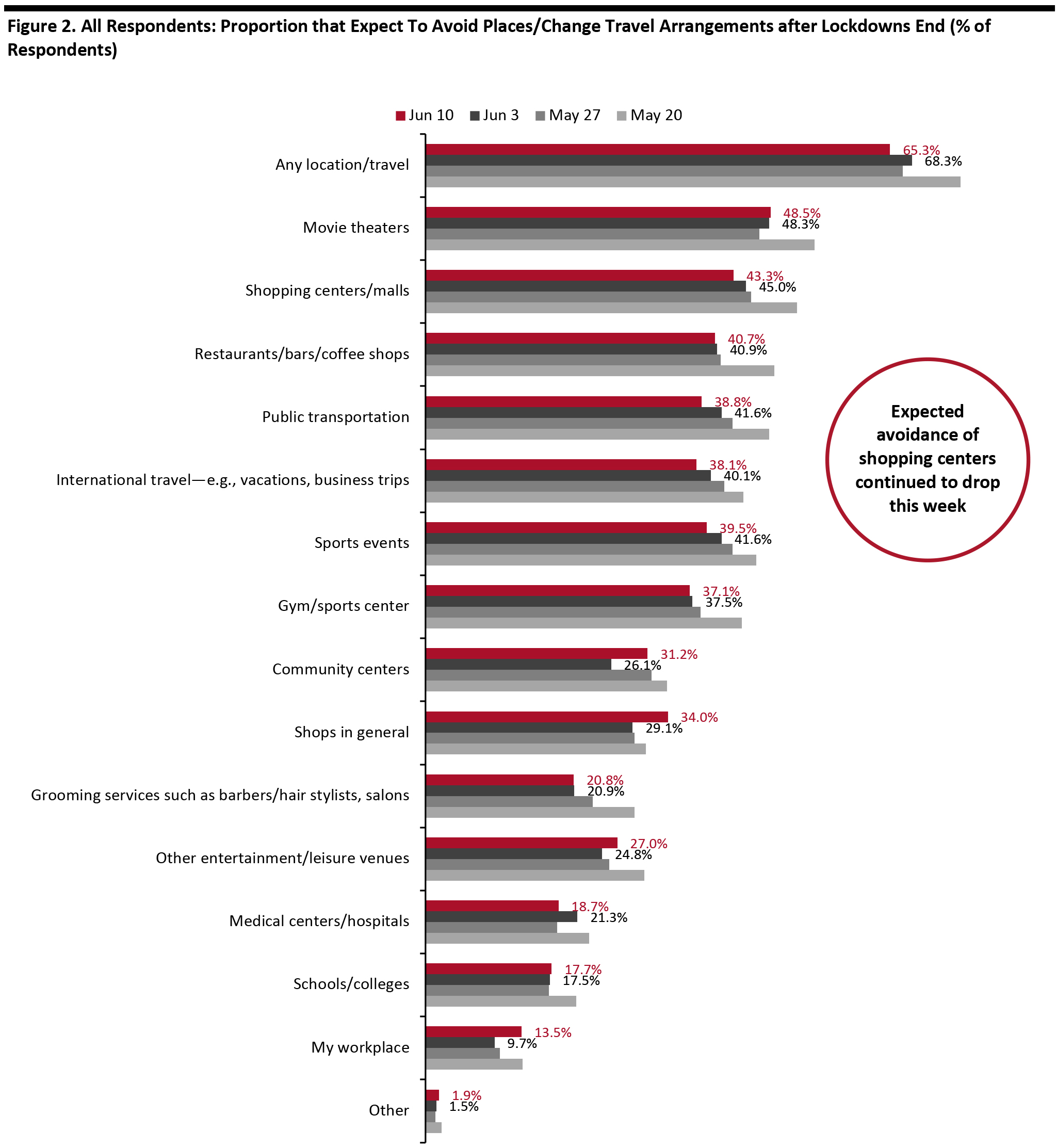 Respondents could select multiple options
Respondents could select multiple options Base: US Internet users aged 18+
Source: Coresight Research [/caption] Expectation To Avoid Public Places for More than Six Months Jumps Back Slightly On the other hand, avoidance actions over the long term continued to increase slightly after the rise last week. Among those expecting to avoid public places or travel after lockdowns end, 40.9% expect to do so for more than six months, up from 38.5% last week. There has been some fluctuation in this figure since the week of May 13. Once again, we noticed only a fraction of respondents expect to avoid public places for less than one month, aligning with the low expected rates of return to regular activities in the next two weeks, shown previously. A total of 76.8% of respondents expect to avoid places for three months or more, slightly up from 75.7% last week. [caption id="attachment_111413" align="aligncenter" width="700"]
 Base: US Internet users aged 18+ who expect to avoid places/change travel arrangements after lockdowns end
Base: US Internet users aged 18+ who expect to avoid places/change travel arrangements after lockdowns end Source: Coresight Research [/caption] Two-Thirds Expect To Retain Changed Behaviors for the Long Term Each week, we ask respondents whether they think they will keep some of the behaviors they have adopted during the coronavirus crisis. This week, some 67.4% of respondents expect to retain some changed behaviors over the long terms, versus 63.2% in last week. [caption id="attachment_111414" align="aligncenter" width="700"]
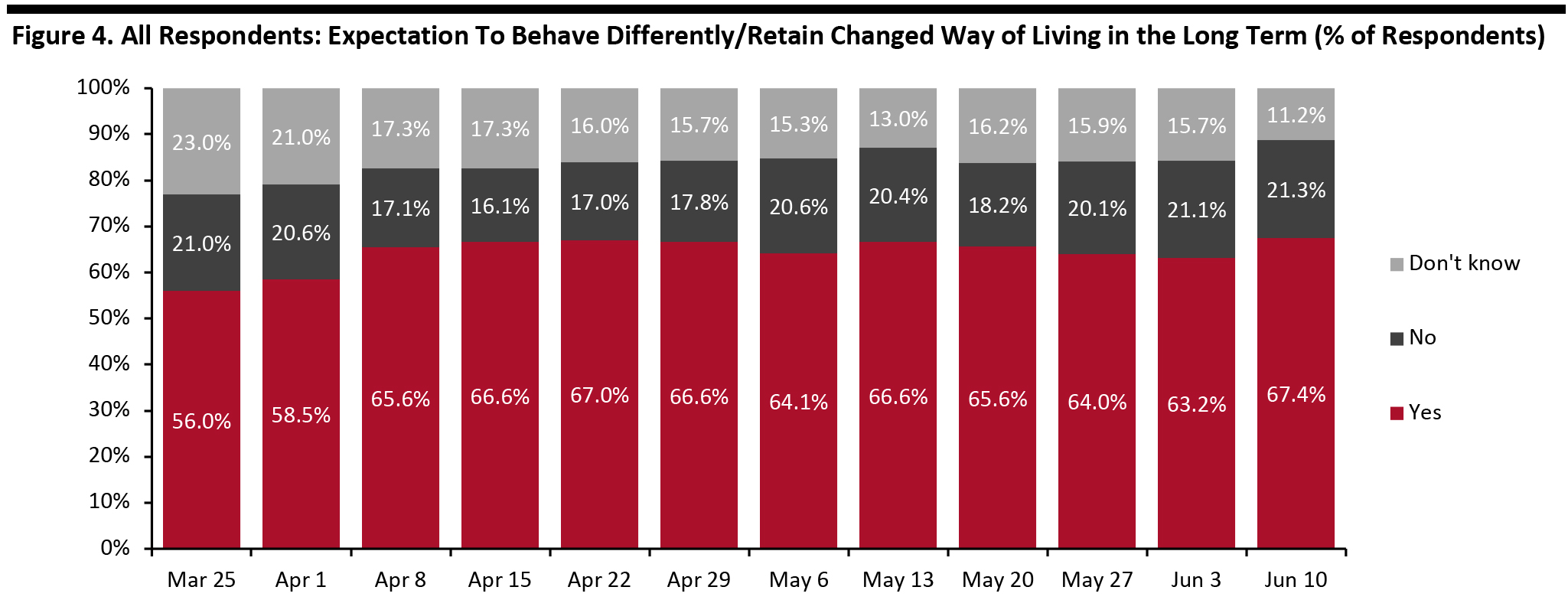 Base: US Internet users aged 18+
Base: US Internet users aged 18+ Source: Coresight Research [/caption] Among those expecting to retain changed behaviors, we have seen a consistent upward trend in expectations to have more hygienic practices starting from the week of May 13, with less than three-quarters expecting to do so this week, a six-percentage-point surge from last week. The proportion of respondents expecting to wear masks/gloves moderated slightly this week, after consistent increases in the past couple of weeks. Almost half expect to do so in long term. We have seen some fluctuation in the proportion of respondents expecting to travel less. This week, less than one-quarter said they would do so, down from almost one-third last week. [caption id="attachment_111417" align="aligncenter" width="700"]
 Respondents could select multiple options *Not provided as an option before May 27
Respondents could select multiple options *Not provided as an option before May 27 Base: US Internet users aged 18+ who expect to behave differently in the long term/retain changed ways of living from the outbreak
Source: Coresight Research[/caption] In the chart below, we focus on trending data in three of the metrics charted above. We represent these as a proportion of all respondents, to represent consumers overall, rather than as a proportion of those expecting to retain changed behaviors (which is what is charted above). Rebased to all respondents, we have seen overall upward trend in expectations to shop less overall. One-quarter of respondents expect to shop less overall, versus 22.6% last week. The proportion of respondents expect to switch their shopping to the e-commerce channel remained stable at three in 10 this week. The proportion of respondents expecting to visit public places less often jumped back after a decline last week. Some 31.4% expect to do so, compared to 28.7% last week. [caption id="attachment_111418" align="aligncenter" width="700"]
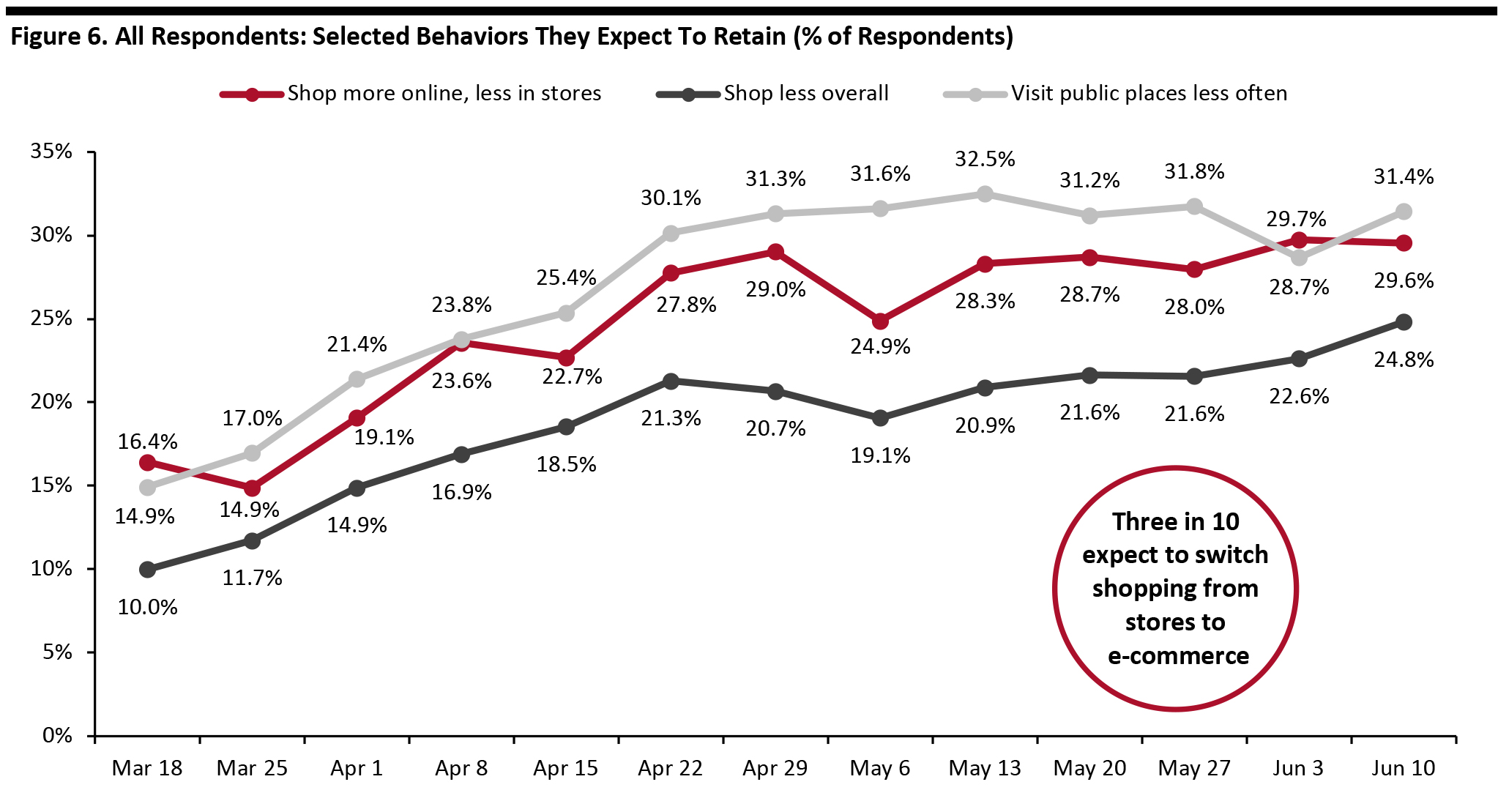 Base: US Internet users aged 18+
Base: US Internet users aged 18+ Source: Coresight Research [/caption] A Little Less than One-Third Expect To Retain Changed Spending Patterns for More than Six Months This week, we saw a slight increase in the proportion of respondents anticipating longer-term impacts on their spending. Among consumers who have changed their spending levels—by buying more or less of any categories—31.8% expect it to be more than six months from now before their spending patterns return to normal, versus 29.5% last week and 30.9% the week before that (although these changes are both within the margin of error). A six-month-plus window now takes us up to of the first half of December at the earliest—well into the holiday season, suggesting that the weakness in consumer demand could persist into this crucial period for retail sales. A total of 73.2% of respondents expect to keep their changed purchasing behaviors for three months or more, slightly up from 71.8% last week. Focusing only on those making fewer purchases, 31.8% expect to return to pre-crisis spending patterns only in more than six months’ time, versus 31.4% last week and 33.3% the week before (Figure 9).
- We show what consumers are buying more of and less of in a separate section later in this report.
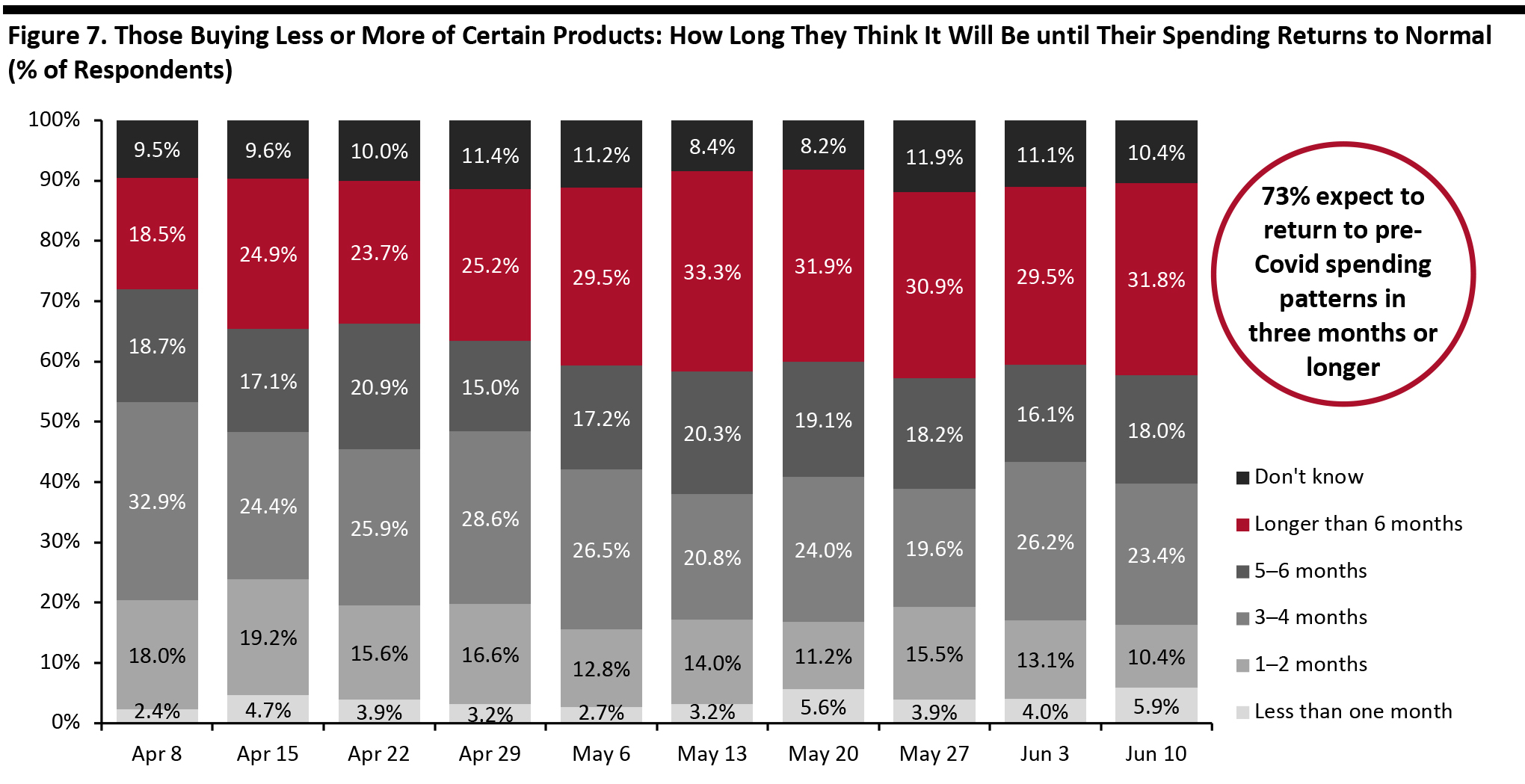 Base: US Internet users aged 18+ who are purchasing any products more or less, because of the coronavirus outbreak
Base: US Internet users aged 18+ who are purchasing any products more or less, because of the coronavirus outbreak Source: Coresight Research [/caption] Figure 8. Those Buying Less of Certain Products: How Long They Think It Will Be until Their Spending Returns to Normal (% of Respondents) [wpdatatable id=246 table_view=regular] Base: US Internet users aged 18+ who are purchasing any products less, because of the coronavirus outbreak Totals may not sum due to rounding Source: Coresight Research Two-Thirds of Consumers Expect the Crisis To Last More than Six Months This week, consumers’ expectations of the length of the crisis continued to rise after the increase last week. Fully 66.9% now expect the severe impact of the outbreak to last more than six months from its start, up from 61.0% last week. As we are now almost three months since the crisis began, the proportion of respondents expecting the severe impact to last three months or more is high at 94.6%, broadly in line with last week. [caption id="attachment_111421" align="aligncenter" width="700"]
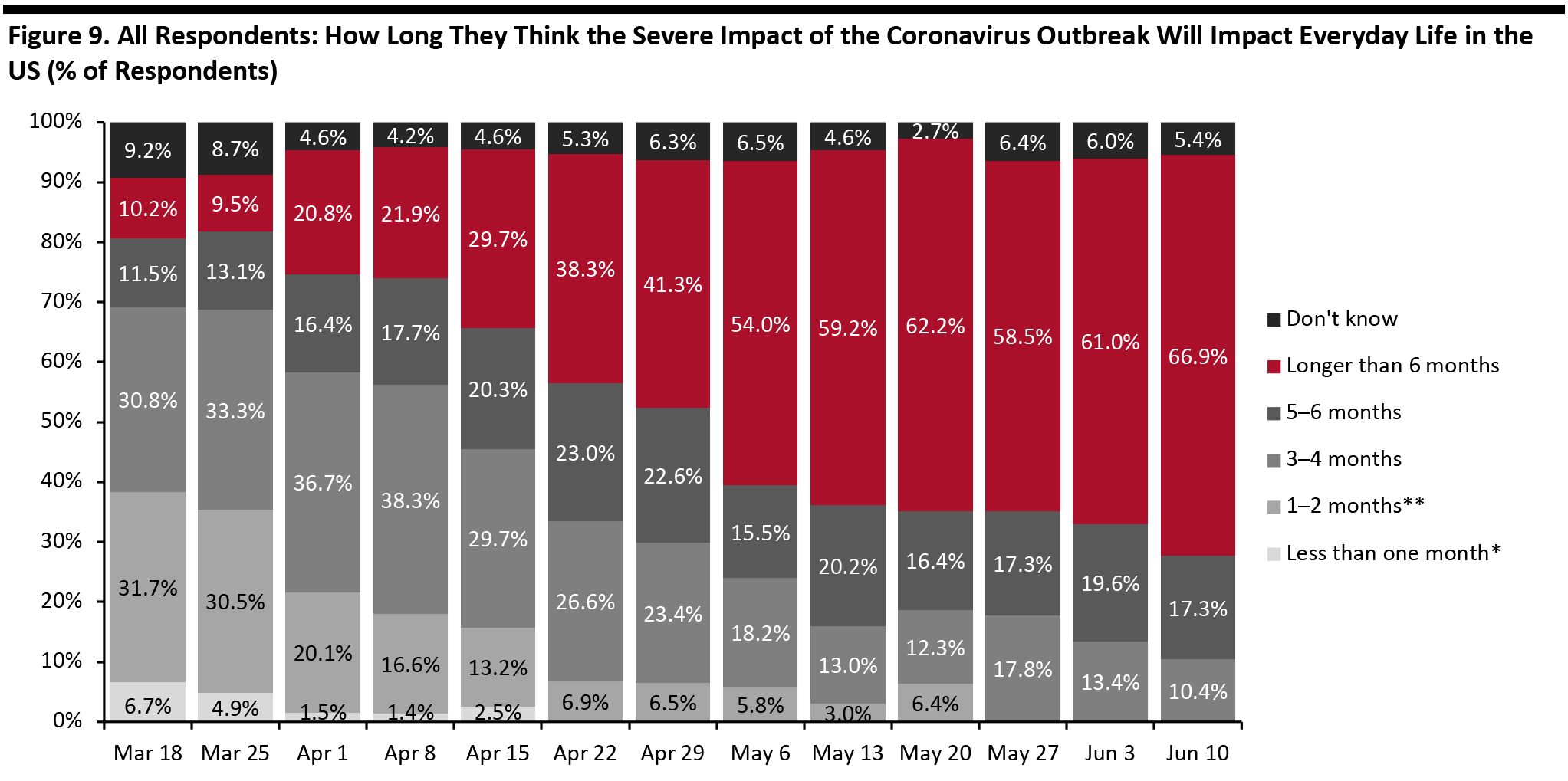 Base: US Internet users aged 18+
Base: US Internet users aged 18+ *Not provided as an option after April 15
**Not provided as an option after May 20
Source: Coresight Research [/caption]
Reviewing Trend Data in Purchasing Behavior
What They Are Buying More Of and Less Of This week, the proportion of respondents both buying less and more dropped a little: 62.7% of respondents are buying more, versus 67.0% last week; and 57.9% are buying less, compared to 61.6% last week.- Note, buying more of certain categories and buying less of certain categories were not mutually exclusive options, so respondents could answer yes to both.
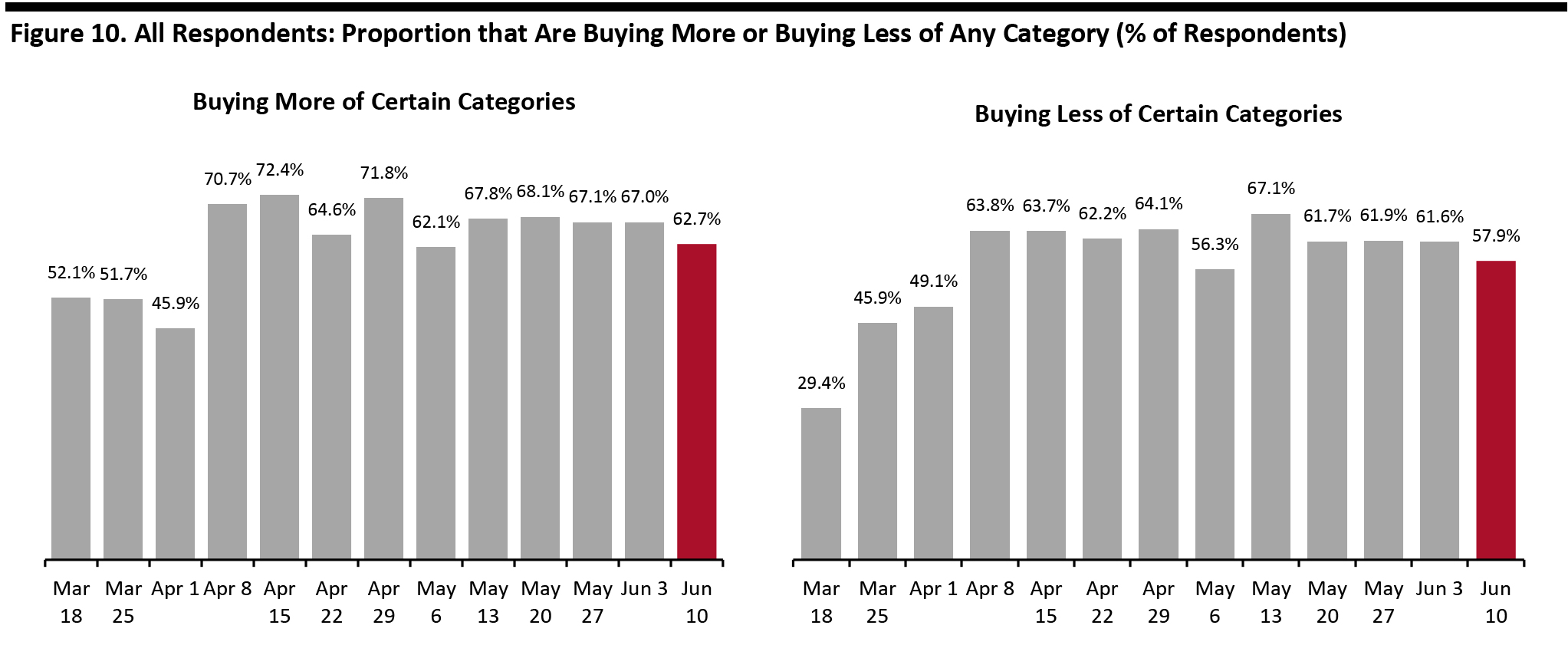 Base: US Internet users aged 18+
Base: US Internet users aged 18+ Source: Coresight Research [/caption] Buying more: Essentials, including household products and food, are still ranked as top categories that consumers are purchasing more of, but we have seen week-over-week declining trends for five consecutive weeks. This echoes our finding of reduced expectations for online grocery shopping in the next two weeks (as shown in Figure 1). Buying less: Apparel remains the number-one category for cutbacks, with 35.2% of respondents this week saying they are buying less in this category, down from 39.2% in the prior week (we show trended data in Figure 13). The positive change broadly aligns with the findings shown earlier, of increased expectations to buy apparel in stores in the coming two weeks. Furniture/home, beauty and electronics continue to be the next-most-cut categories, but while the proportion of respondents cutting furniture/home and electronics purchases was stable week over week, the proportion cutting beauty purchases increased versus last week. Ratio of less to more: The ratio for clothing and footwear stood at 3.5 this week versus 3.7 last week; in May, this ratio stood at around 5, so we are seeing an incremental return to spending. The ratio for furniture, furnishings and home improvement was 2.6 this week versus 2.8 last week. Beauty products stood at 3.5 this week versus 2.8 last week. [caption id="attachment_111423" align="aligncenter" width="700"]
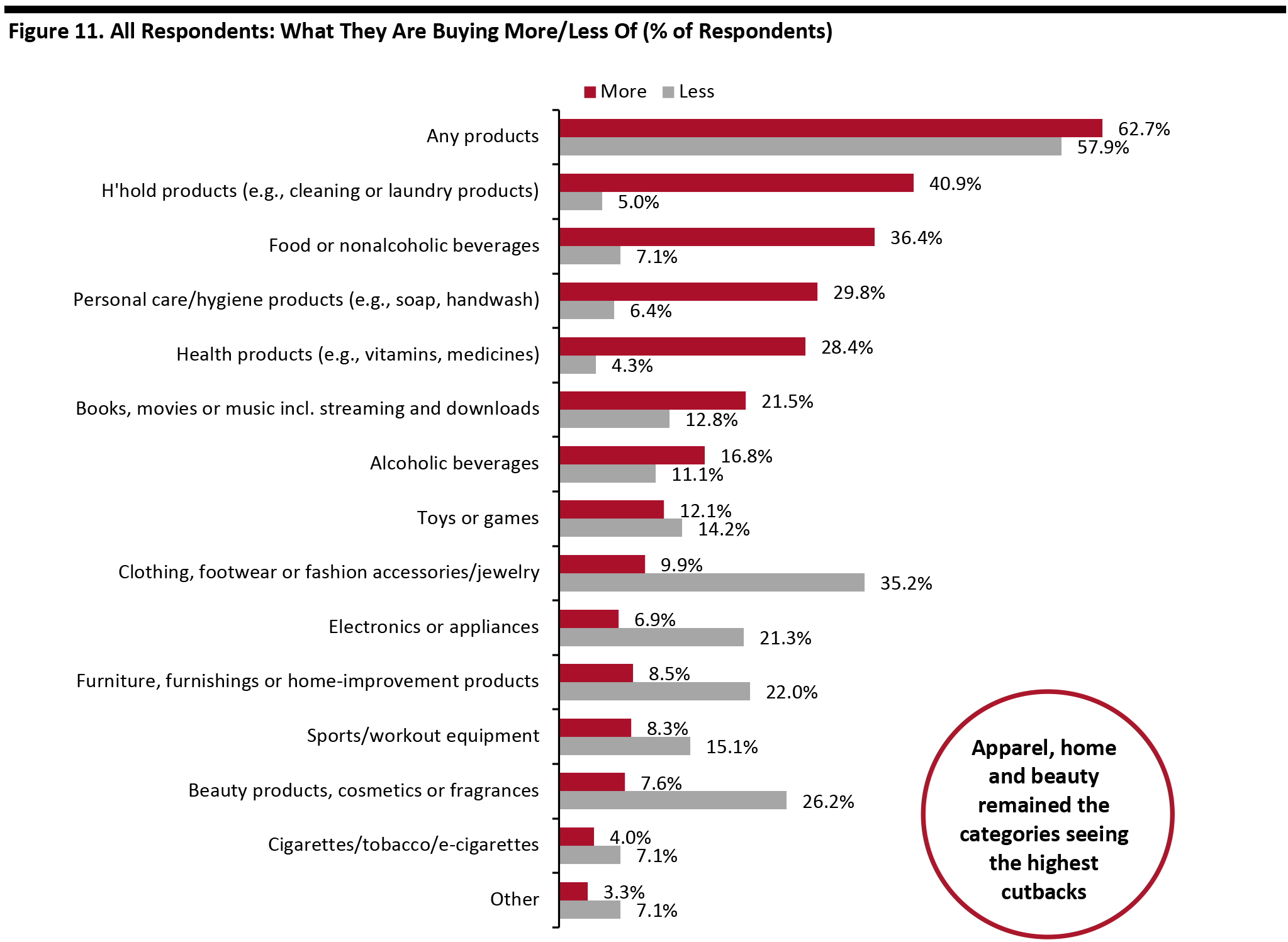 Respondents could select multiple options
Respondents could select multiple options Base: US Internet users aged 18+
Source: Coresight Research [/caption] [caption id="attachment_111439" align="aligncenter" width="700"]
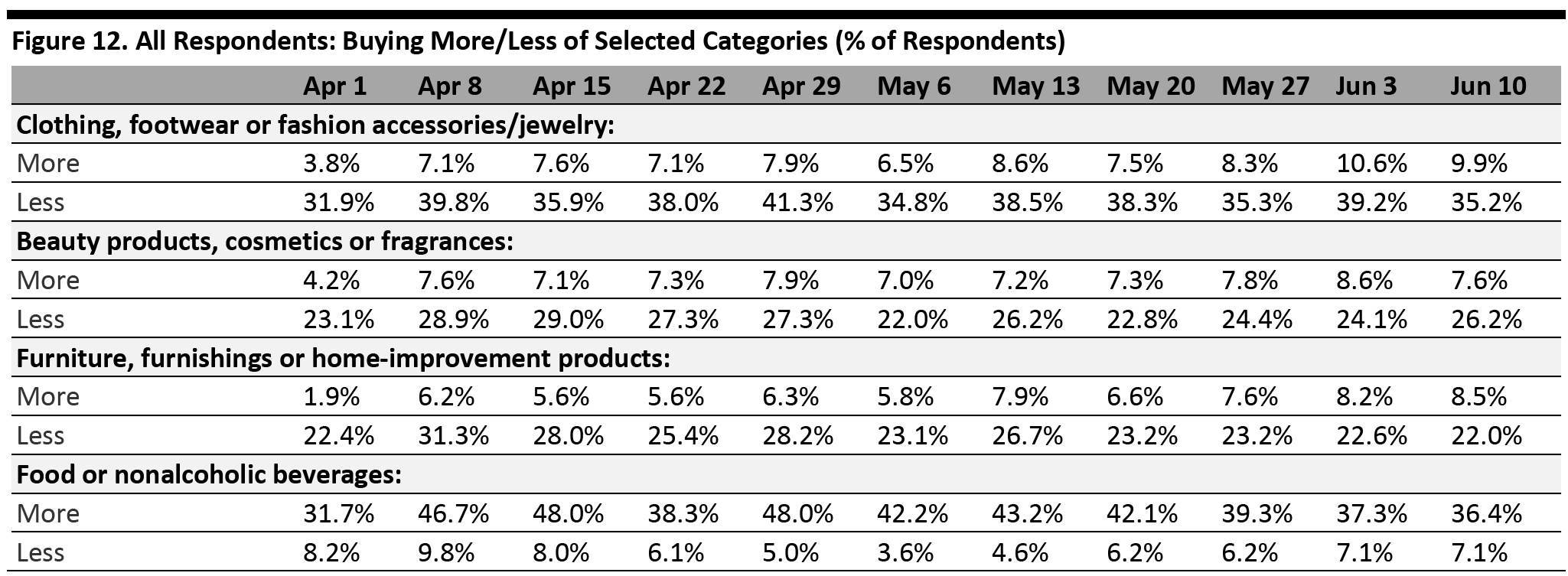 Base: US Internet users aged 18+
Base: US Internet users aged 18+ Source: Coresight Research [/caption] A Little Over Seven in 10 Are Switching Spending Online The proportion of consumers switching spending to e-commerce shows no sign of weakening, even though lockdowns in most states have eased or lifted, with retail stores having begun to reopen from the beginning of May. Some 71.6% of consumers are buying more online this week, versus around 70% in the past couple of weeks. [caption id="attachment_111424" align="aligncenter" width="700"]
 Base: US Internet users aged 18+
Base: US Internet users aged 18+ Source: Coresight Research [/caption] What Consumers Are Buying More Of Online Among the respondents making more purchases online, we saw a 10-percentage-point plunge in the proportion of respondents buying household products: Only 37.6% are buying these products online, down from 48.3% last week. The proportion of consumers who are buying food online also fell back to 35.0% this week after an upswing last week. This mirrors our earlier finding that consumers now have lower expectations of undertaking grocery shopping online in the coming two weeks. In discretionary categories, we saw a stabilization in the proportion of consumers who are buying apparel, furniture/home and beauty online. The figures below are a proportion of those who are buying more online in general. Considered as a proportion of all respondents (representing consumers in general), buying more apparel online stood almost the same at around 24% this week from last week, and buying more beauty online came at 15.4% versus 14.2% last week. [caption id="attachment_111425" align="aligncenter" width="700"]
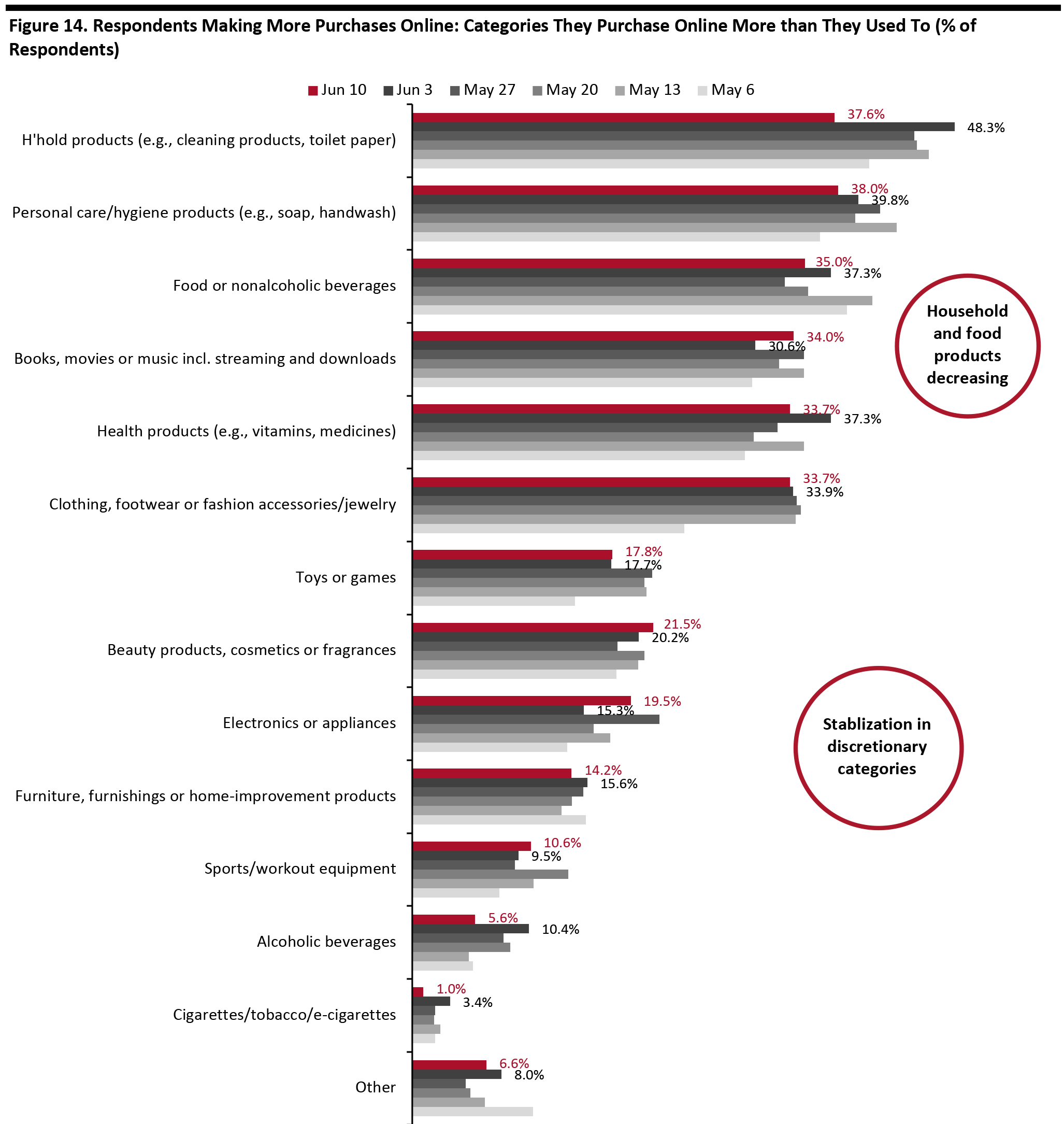 Respondents could select multiple options
Respondents could select multiple options Base: US Internet users aged 18+ who make more purchases online than they did before the coronavirus outbreak
Source: Coresight Research [/caption]